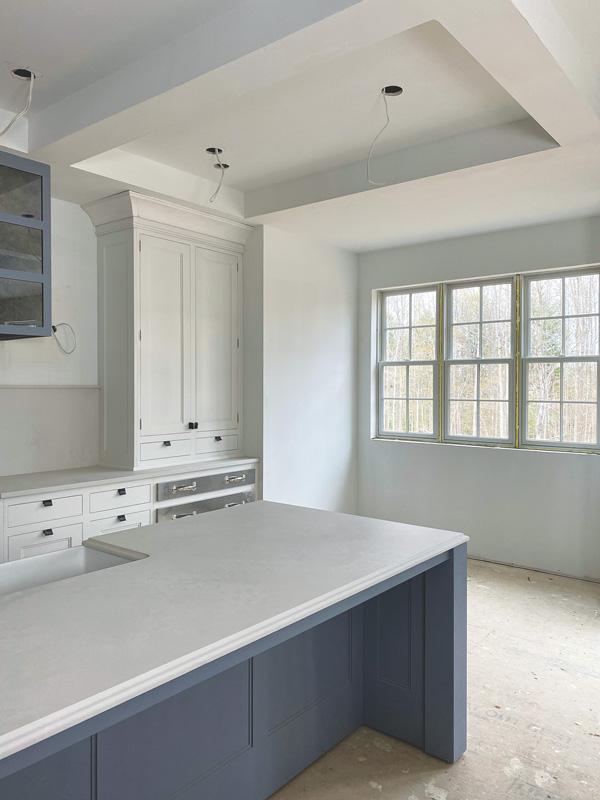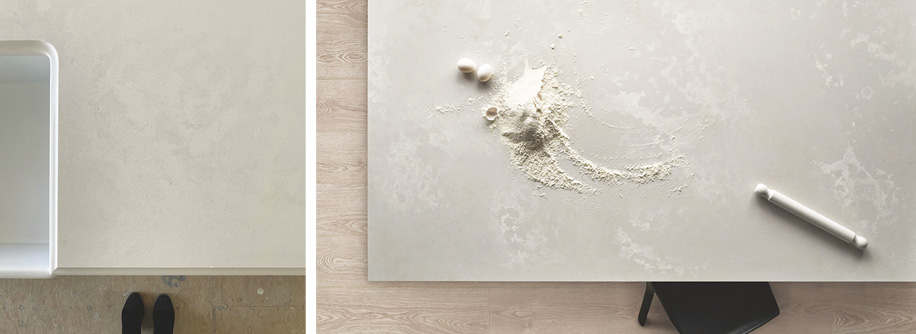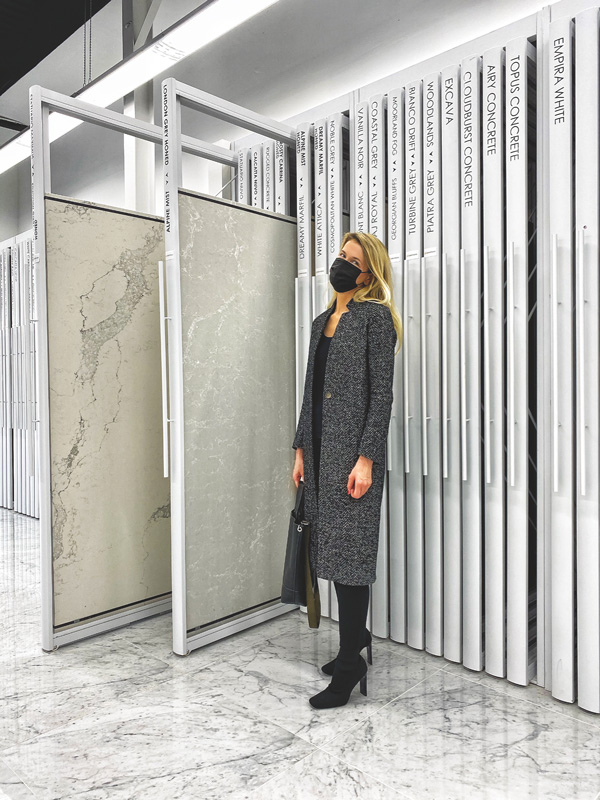Conversations with Kate: Counter Intelligence
Writer Ren Miller | Designer Christopher Peacock | Architect Dan D'AgostinoKitchen countertops are more than just a pretty face

“Cloudburst Concrete,” a quartz product by Caesarstone, was chosen for its understated design and subtle movement. Note the edge treatments: ogee on the island and eased-edge on the perimeter countertops.
Countertops are the unheralded workhorse of the kitchen. Probably nothing gets more use, so it’s important to choose countertop material that you love but that also stands up to the rigors of all that happens in the kitchen. You’ll find many options, and your final choice may differ from your first inclination. That’s the case for Kate Rumson, the founder and creative director of The Real Houses of Instagram (@the_real_houses_of_ig). Design NJ has been following the planning and construction of the home she is building in central New Jersey. In this installment, Kate explains how she decided which countertop material would best suit her needs.
REN: There are many choices of countertop material, including granite, marble, soapstone, quartz, solid surface and manmade laminate. Which type have you chosen for your kitchen?
KATE: When we started designing the kitchen, I was planning to go with natural marble. But once the cabinetry was installed and we got closer to the day when I needed to finalize my countertop material, I just couldn’t commit to marble in the kitchen. As beautiful as it is, marble requires maintenance and is a porous material that could easily stain. I know myself and know how much it would bother me to see stains on my beautiful countertops. I don’t want to live my life constantly worrying about something happening to my countertops every time we cook or entertain in the kitchen, so I changed my mind at the last minute and went with quartz by Caesarstone. Quartz is a non-porous material so I won’t have to worry about stains or maintenance.
REN: Most types of countertops come in various colors and patterns. What did you choose, and what factors went into your decision?
KATE: I’m drawn to natural materials that look and feel organic and earthy, and finding a countertop that would give me that aesthetic, would not stain and would require no maintenance was a challenge. A few months ago, I came across a photo of “Cloudburst Concrete” by Caesarstone and loved its interesting but understated design and subtle movement, deepened by a textured finish. Once I realized I couldn’t commit to natural marble, “Cloudburst Concrete” was the first alternative that came to mind, and after seeing it in a full slab I knew it was the perfect countertop for my new kitchen.
REN: Do certain edge profiles work better than others in different design styles?
KATE: Straight-edge profiles work well in contemporary, transitional or modern kitchens. In a more traditional kitchen, you may want to choose a curved edge to tie it to crown moldings or intricate cabinetry details. I would describe my kitchen as fresh traditional with a modern twist so we combined two edge profiles: clean and simple eased-edge on the perimeter of the kitchen and ogee on the island.
REN: Did you choose the same quartz as a backsplash or another complementary material?
KATE: I went with the same quartz on the backsplash but only for 24 inches above the countertop—not all the way up to the ceiling (see photo above). I feel that too much tile, glass or stone could make a space feel cold and not as cozy. I opted for a 2-foot quartz backsplash to protect the wall from grease and food splatter during cooking, and plan on installing beautiful wall paneling above the backsplash to add another layer of texture and make the space look and feel warmer and more interesting.
REN: Waterfall edges add a sleek look. Can you explain what they are and whether you decided to use them in your kitchen?
KATE: A waterfall edge is a design that makes a 90-degree angle on the sides of the countertop. Rather than simply ending with a finished edge, the countertop turns toward the floor and continues down the sides of the island. I like waterfall edges but didn’t think they were the right option for the style of my kitchen as they tend to look more contemporary or modern.
REN: Any tips on where and how to shop for countertops?
KATE: I would recommend connecting with a reputable fabricator and asking for their guidance through the process. Fabricators work with many different materials, showrooms and stone yards, and they will be able to point you in the right direction whether you’re looking for something specific or you’re not sure where to start. I’ve been working with Faithful Countertops in Paterson from the very beginning, and they’ve been incredibly helpful with everything from making recommendations on where to look for stone in full slabs to answering questions about seams and edge profiles and their flawless templating, fabrication and installation services.
REN: What trends are you seeing in countertop materials and design?
KATE: As people are spending more time at home and are extra conscious about cleanliness and tidiness, I’m seeing strong interest in white countertops again. A safe and clean environment is key to peace of mind, and light surfaces often evoke a sense of wellness and serenity—something many of us crave after living through a global pandemic.

COUNTERTOP | Kate’s quartz countertop (left) has a textured finish, won’t stain and has no maintenance requirements other than wiping clean, an advantage over marble, which was her first consideration. INSPIRATION | This promotional photo of “Cloudburst Concrete” by Caesarstone sparked Kate’s interest to find out more about the quartz product.

